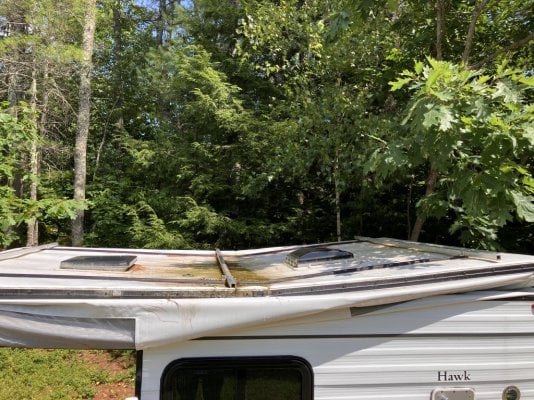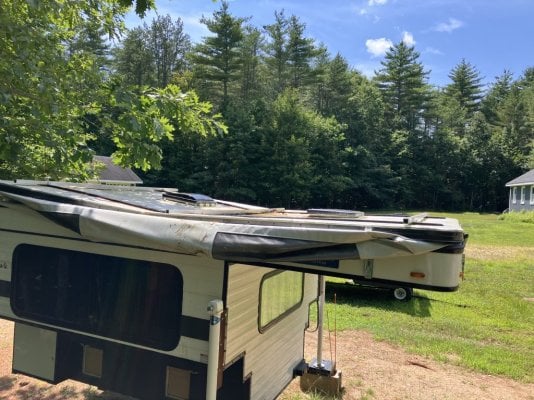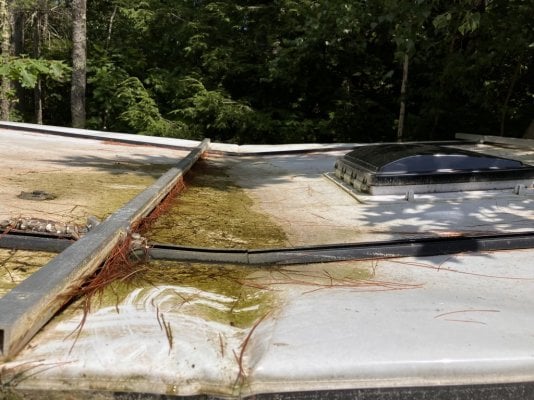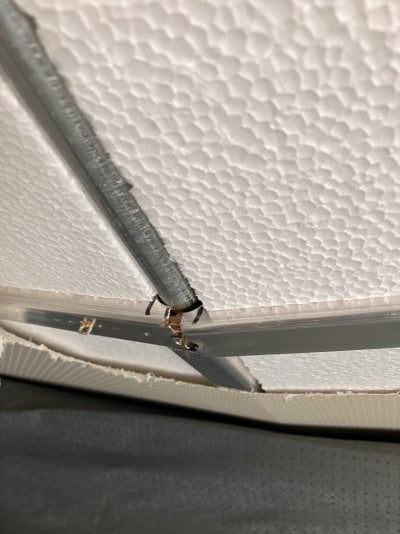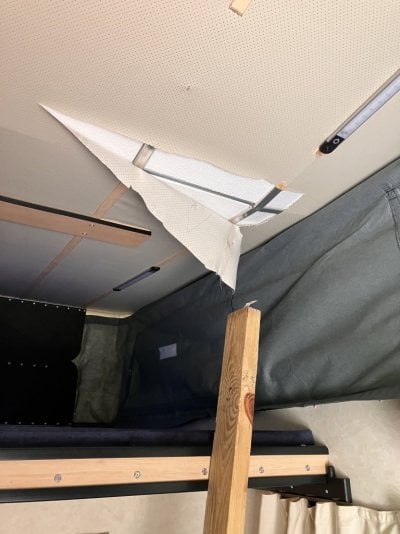Hey everyone, long time lurker, but this is my first post.
This is first and foremost a warning to others. If anyone can give me some ideas about what to do next that would be great too. I did a bit of searching but didn't come up with any better place to post this. If this is an inappropriate post for some reason someone please let me know.
The warning: DO NOT ALLOW SNOW TO ACCUMULATE ON TOP OF YOUR RAISED FWC ROOF! ROOF DAMAGE DUE TO SNOW LOAD CAN OCCUR!
As the subject alludes, unfortunately a snow load partly collapsed the roof of my 2019 FWC Hawk. The roof was up, and it was about an 8-10" snow accumulation when I decided I should go try to clean it off to reduce the load. I was up on a ladder with my long snow brush and I had already dragged a few swaths off the edge when the whole thing dropped an inch or two. I investigated and the side fabric seemed a little weird, like it didn't fit right anymore, but at that point I couldn't figure out what was wrong. I continued cleaning off the rest of the snow and when I went inside to lower the camper I saw that some of the internal roof structure (the lengthwise parts) had clearly broken or folded and were pressing downward on the headliner material from from above. I got the top down without further incident, and haven't really done anything with it since.
My Hawk is a 2019. I have aftermarket full-length Rhino Rack roof rack tracks and DIY aluminum tube crossbars up there, but that's it. I transported a canoe up there once (for about 60 miles on pavement), but the top was down the whole time. If anything, it seems like my roof tracks might have stiffened the structure and prevented the break from being even worse. The roof is still waterproof and all the visible components are still intact - it seems that just the internal structure is the only damage. With the top down I'm able to latch everything and it all seems roadworthy. I'm not really sure yet how to go about repairing it or getting it repaired. I'll reach out to FWC directly and see what they say but haven't done so yet. Anyone seen this before? Are there any threads on FWC roof structure repair? I found a bunch of threads about people speculating about snow load issues, but unfortunately for me I have gone beyond the speculation stage.
I will say that I believe there would not have been a problem if the roof had been down. The break occurred almost exactly mid-span between the front and rear end supports. If the top had been down the longest span would be side-to-side which is much shorter, and the support across the front and back would have further strengthened the span in the side-to-side direction. Maybe that goes without saying, but I'll mention it anyway in case it helps someone out there.
This is first and foremost a warning to others. If anyone can give me some ideas about what to do next that would be great too. I did a bit of searching but didn't come up with any better place to post this. If this is an inappropriate post for some reason someone please let me know.
The warning: DO NOT ALLOW SNOW TO ACCUMULATE ON TOP OF YOUR RAISED FWC ROOF! ROOF DAMAGE DUE TO SNOW LOAD CAN OCCUR!
As the subject alludes, unfortunately a snow load partly collapsed the roof of my 2019 FWC Hawk. The roof was up, and it was about an 8-10" snow accumulation when I decided I should go try to clean it off to reduce the load. I was up on a ladder with my long snow brush and I had already dragged a few swaths off the edge when the whole thing dropped an inch or two. I investigated and the side fabric seemed a little weird, like it didn't fit right anymore, but at that point I couldn't figure out what was wrong. I continued cleaning off the rest of the snow and when I went inside to lower the camper I saw that some of the internal roof structure (the lengthwise parts) had clearly broken or folded and were pressing downward on the headliner material from from above. I got the top down without further incident, and haven't really done anything with it since.
My Hawk is a 2019. I have aftermarket full-length Rhino Rack roof rack tracks and DIY aluminum tube crossbars up there, but that's it. I transported a canoe up there once (for about 60 miles on pavement), but the top was down the whole time. If anything, it seems like my roof tracks might have stiffened the structure and prevented the break from being even worse. The roof is still waterproof and all the visible components are still intact - it seems that just the internal structure is the only damage. With the top down I'm able to latch everything and it all seems roadworthy. I'm not really sure yet how to go about repairing it or getting it repaired. I'll reach out to FWC directly and see what they say but haven't done so yet. Anyone seen this before? Are there any threads on FWC roof structure repair? I found a bunch of threads about people speculating about snow load issues, but unfortunately for me I have gone beyond the speculation stage.
I will say that I believe there would not have been a problem if the roof had been down. The break occurred almost exactly mid-span between the front and rear end supports. If the top had been down the longest span would be side-to-side which is much shorter, and the support across the front and back would have further strengthened the span in the side-to-side direction. Maybe that goes without saying, but I'll mention it anyway in case it helps someone out there.


